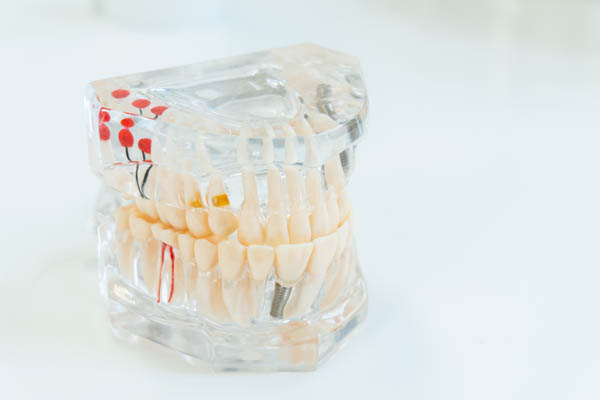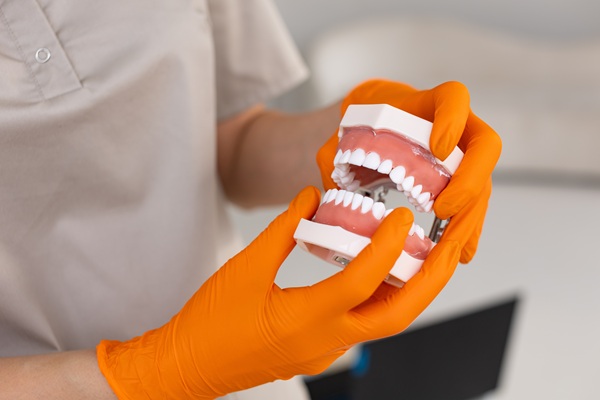Placing Crowns on Dental Implants

When you’re considering having dental implants surgery, you may be curious about the steps following the initial surgery of the implants into your mouth. The next stage is crown placement on dental implants. The crown will sit on top of the implant and work together to help your new teeth work and feel just like a natural tooth.
Crown placement procedure
After dental implants have been integrated into the bone, the dentist will then schedule another surgery. During this surgery, they will expose the top of the implant, placing a collar over it to help guide the gum tissue for proper healing. When the gum tissue has healed, the collar will be removed and replaced with abutment.
Before this can be done, your dentist will make impressions of the abutment to help make the dental crown of the implant. These impressions are made so that the crown will fit securely on your dental implant to cover any gap created by the loss of a tooth.
Temporary crowns
Before your permanent crown is fabricated, the dentist will place a temporary crown onto the implant. This will have to be removed before the permanent crown can be placed. A local anesthetic may be used to numb the area around the dental implants before the crown is removed. All traces of dental cement will be removed from the implants before the permanent ones are placed.
Ensuring a good fit
Before a dentist locks in your permanent crown, they will check to ensure they fit properly. This process is done by placing the crown on your implant without cementing or screwing it into place. If the crown doesn’t fit right, they will trim it down until the desired fit is achieved.
Placement of the permanent crown
During this stage, the dentist will seal the crown. When cement is used, they will put dental cement inside the crown and place it over your dental implants. After a few minutes, the cement should be set into place. If there is any excess cement left over, it will be cleaned, and they will recheck your bite to ensure they fit properly.
If your dentist uses a screw mechanism, they will screw the crown over the abutment until it has a firm placement. Screwed-in crowns are much more easily removed than cemented ones.
Caring for your crowns
After your permanent crowns have been placed, your dentist will then provide any aftercare instructions. Depending on what mechanism was used to secure the crowns in place, your aftercare instructions may differ. Dental cement can take a few hours to set, which may discourage you from using the crown for at least 24 hours. They may also advise that you check your bite again the following day once the cement has fully hardened.
Having dental crowns placed on dental implants is considered to be an easy, straightforward procedure. Follow any aftercare instructions that your dentist provides to ensure you get the best possible lifespan out of your new teeth.
Request an appointment here: https://www.lightbreezedental.com or call Light Breeze Dental at (949) 274-4719 for an appointment in our Irvine office.
Check out what others are saying about our dental services on Yelp: Dental Implants in Irvine, CA.
Recent Posts
There has been a lot of talk about dental implants in recent years. Dentists recommend them, and patients benefit from the results of the treatment. Implants restore the full function of the mouth and revitalize smiles. People can enjoy newfound self-esteem and the self-image and health they have been looking for. You may wonder whether…
Dentists generally recommend dental implants as a natural choice for replacing missing teeth. If you play sports regularly, especially contact sports, you may be worried about continued participation after having your lost teeth replaced. This article covers what you need to know about playing sports with dental implants.Every sport has required skills, levels of fitness…
If you are missing at least one or more teeth, you may qualify as a candidate for dental implants. Dental implants are the best option for replacing missing teeth. Having missing teeth can harm your oral health, and untreated tooth loss can interrupt your chewing ability and even affect the structure of your mouth. If…
A dental implants restoration can replace a missing tooth that falls out naturally, gets knocked out or is extracted. A dental implant restoration is often recommended after tooth extraction, as it prevents bone loss from occurring and offers cosmetic and functional benefits. There are several ways to replace a missing tooth after an extraction, including with…


